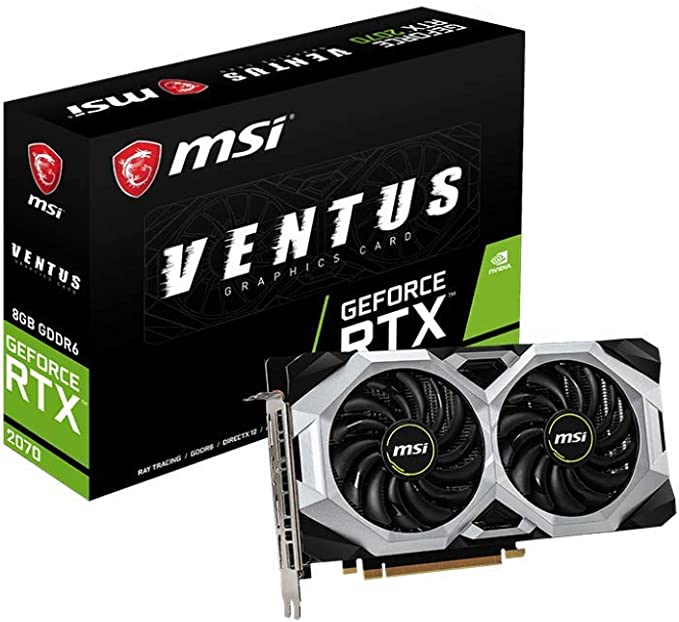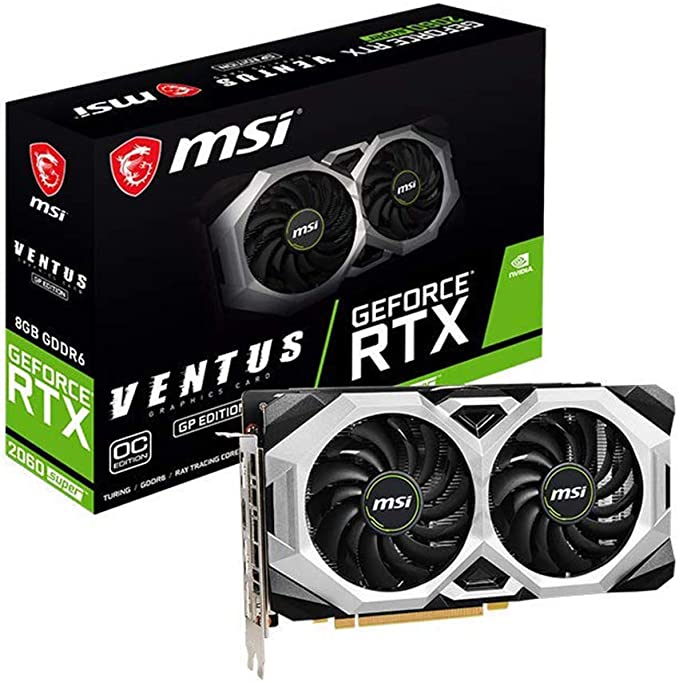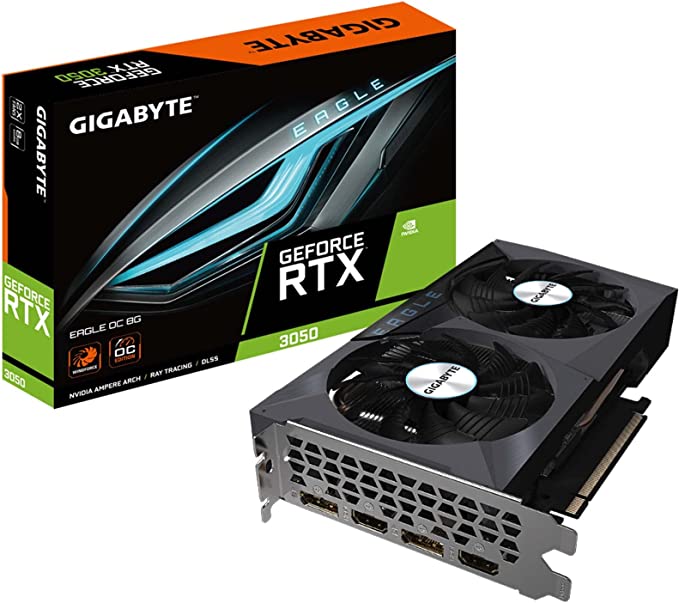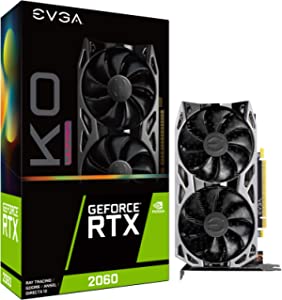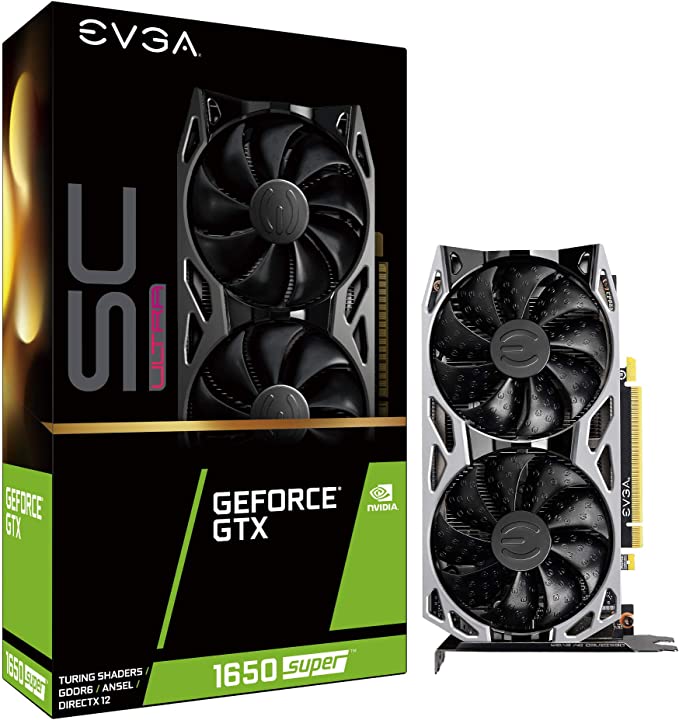GPUs have recently undergone an insane boom, which has driven their prices up significantly higher than normal. While prices seem to be stabilizing, GPUs can still be rather expensive, especially for streaming.
So, are there any budget GPUs that can play games and stream at the same time and are they worth the money?
1. GeForce RTX 2070
SPECIFICATIONS
| Name | GeForce RTX 2070 |
| Memory | 8 GB |
| Memory Type | GDDR6 |
| Fans | 2 |
| Interface | PCIe 3.0 x16 |
| Display Ports | 1x DVI, 1x HDMI 2.0, 2x DisplayPort 1.4a, 1x USB Type-C |
| Dimensions | 8.9″ x 5.04″ x 1.6″ (L x W x H) |
WHERE TO BUY
View On AmazonPROS
- Great for 1440p
- Can handle 4k on certain games
- Turing architecture makes streaming extremely easy
CONS
- No SLI available
- Most expensive budget GPU
Finally we have the RTX 2070. This GPU is a beast, in general. With it, you’ll be able to run and stream pretty much any game you want at 1440p. This GPU can even hit 4k resolution on particular titles.
If you choose 1080p, however, you’ll be able to stream your games on medium to high settings while hitting 240+ FPS the entire time. So, as you can tell this card is absolutely fantastic.
If you plan to play games like Valorant, League of Legends, or Fortnite, this card may even be a little overkill if you’re a beginner streamer. However, if you’re playing games like Apex Legends, GTA V, or any other AAA games and want a quality stream, then this is the budget GPU you need.
You’re pretty much guaranteed to get 60 FPS with 1080p quality, which is the minimum you should always aim for.
This barely makes it into the budget category, but for less than $500 you’re getting a great GPU with all of the NVIDIA features that make streaming easy. You’ll have the turing architecture which is the gold standard for streaming cards, and you’ll have 8 GB of VRAM which will make rendering any game a breeze.
The only major downsides to this GPU are its price and its lack of SLI. SLI just lets you use two cards at once, which most people are not interested in anyways. However, if you are on a budget and have an old GPU that is SLI compatible, that is something you might want to look into.
The second downside is that, while this is a budget GPU, it still has a hefty price tag. If you’re streaming less-demanding games, then you can save a lot of money and pick up a cheaper card that will have more than enough power to handle them.
With that being said, if you’re going to go overkill on any component in your gaming PC, it might as well be your GPU.
2. GeForce RTX 2060 Super
SPECIFICATIONS
| Name | GeForce RTX 2060 Super |
| Memory | 8 GB |
| Memory Type | GDDR6 |
| Fans | 2 |
| Interface | PCIe 3.0 x16 |
| Display Ports | 1x DVI, 1x HDMI 2.0, 2x DisplayPort 1.4a, 1x USB Type-C |
| Dimensions | 9.1″ x 5.0″ x 1.7″ (L x W x H) |
WHERE TO BUY
View On AmazonPROS
- Great for streaming at 1080p or 1440p
- Very powerful card, especially for its price
- Runs at low temps
- Can stream on high settings
CONS
- May have to play with OBS features to get a smooth stream
This card is right on the edge of budget, but it’s still fairly cheap for the amount of performance you can get from it. I talked about the 2060 earlier on the list, and the 2060 Super is an upgraded version of that card.
You’ll be able to stream many games on high settings without dropping many frames. If you’re on max settings, you may or may not be able to hit 144 FPS depending on the game, but you should be able to hit 60+ no problem.
8 GB of VRAM is good, as I’ve said. I’d honestly prefer if this had more (of course), but 8 will have to do.
When it comes to streaming, the higher resolution the better. So the fact that this card can hit that 1440p mark is fantastic. Of course, everyone loves 4k and it’d be great to be able to stream at that quality, but it’s just not happening with a $400 GPU.
So, as far as price goes, this is a fantastic card and you’ll definitely be getting your money’s worth.
If you’re a streamer that wants to stream Valorant, Fortnite, League, etc then this is a really good card and will do everything you want it to. Even if you want to stream Apex Legends or Battlefield this card will have your back, even if your frames drop a little bit.
Since this card can stream pretty much any game at 60+ FPS, it’s one of my favorite budget cards on this list.
3. GeForce RTX 3050
SPECIFICATIONS
| Name | GeForce RTX 3050 |
| Memory | 8 GB |
| Memory Type | GDDR6 |
| Fans | 2 |
| Interface | PCIe 4.0 x8 |
| Display Ports | 1x HDMI 2.1, 3x DisplayPort 1.4a |
| Dimensions | 8.39″ x 4.72″ x 1.61″ (L x W x H) |
WHERE TO BUY
View On AmazonPROS
- Easy 1080p streaming on high settings
- 8 GB of VRAM
- Much better than similarly priced options
- Runs at low temps
CONS
- Slower than some other cards (ie RTX 2060 Super)
At this point in the list, you’re going to get similar performance out of most of the cards. Since all of these NVIDIA cards have a built-in encoder in them, streaming will never be an issue and you’re just going to look at how the card performs.
Of course, if you want to stream with high resolution and high FPS, you’ll want a beast of a card.
This card is great, you should be able to easily hit 1080p or 1440p. With that being said, the reason it is number 3 despite being an RTX 30xx card is because it gets outperformed by “lesser” cards.
The 2060 Super is next on this list and honestly the better card. That card is also $100 more expensive, though.
If this card falls within your budget, then you will not regret the purchase. It is a solid GPU that will handle just about any game you throw at it. You can expect well over 60 FPS and probably over 140 FPS with most games, even on high settings.
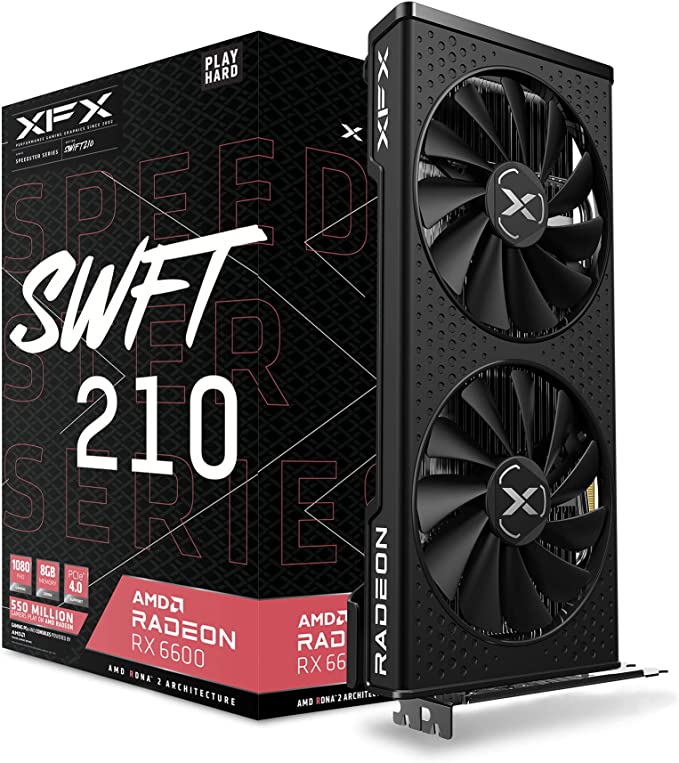
4. Radeon RX 6600
SPECIFICATIONS
| Name | Radeon RX 6600 |
| Memory | 8 GB |
| Memory Type | GDDR6 |
| Fans | 2 |
| Interface | PCIe 4.0 x8 |
| Display Ports | 1x HDMI 2.1, 3x DisplayPort 1.4a |
| Dimensions | 9.49″ x 5.16″ x 1.61″ (L x W x H) |
WHERE TO BUY
View On AmazonPROS
- Can hit 1080p easily
- Affordable
- Cool and quiet
- 8 GB of VRAM
CONS
- Weak Ray Tracing
- No NVENC technology but has its own encoding
This card is on par with the previous NVIDIA cards when it comes to pure performance. However, these cards do not have NVENC technology. AMD cards do have their own encoders but they aren’t as good as NVIDIA encoders.
I’d only recommend going with an AMD card if you have a really good CPU. You can tell your streaming software to use your CPU instead of your GPU for encoding.
Generally speaking, CPU encoding will create a better looking stream anyways. If you do go this route, then the Radeon RX 6600 will be great.
This GPU will be able to handle any game at about 720p. If you plan to stream at 1080p then I’d highly recommend a NVIDIA card or CPU encoding. This card will be able to handle the 1080p, but it’s likely that you’ll experience some frame drops, which isn’t fun for anybody.
5. GeForce RTX 2060
SPECIFICATIONS
| Name | GeForce RTX 2060 |
| Memory | 6 GB |
| Memory Type | GDDR6 |
| Fans | 2 |
| Interface | PCIe 3.0 x16 |
| Display Ports | 1x DVI, 1x HDMI 2.0, 2x DisplayPort 1.4a, 1x USB Type-C |
| Dimensions | 7.96″ x 4.38″ x 1.54″ (L x W x H) |
WHERE TO BUY
View On AmazonPROS
- Great for 1080p streaming
- Can reach 1440p in some games
- Runs at cool temps
CONS
- High power consumption
This is the first card on this list that can probably handle any game you throw at it (even AAA games) without much issue. Even though it is a budget card, it is still a really solid choice.
As I’ve talked about plenty on this list already, NVIDIA cards have the built-in encoder, which will take a huge load off of the card itself when it comes to streaming. This card has 6 GB which I said was probably the minimum I’d consider if I wanted to stream.
I’ve had 4 GB cards in the past and have had significant frame drops even when I wasn’t streaming. These frame drops were remedied as soon as I upgraded to a 6 GB GPU, so I’ll always look for 6+ GB of VRAM.
You’ll be able to stream your gameplay with your settings on high and at 1080p. This is the gold standard of streams, making this almost a perfect option.
Of course, if you go with a more modern card, your graphics will be that much better and your frames will be that much higher. However, this will do.
If you’re only looking to stream games like Valorant, League of Legends, or other easy-to-run games, then this card will work and you’ll probably even be able to hit 1440p. If you want to stream more intense games, then you’ll be stuck at 1080p unless you upgrade or drop settings.

6. GeForce GTX 1660 Super
SPECIFICATIONS
| Name | GeForce GTX 1660 Super |
| Memory | 6 GB |
| Memory Type | GDDR6 |
| Fans | 2 |
| Interface | PCIe 3.0 x16 |
| Display Ports | 1x DVI, 1x HDMI 2.0, 1x DisplayPort 1.4a |
| Dimensions | 8.0″ x 1.7″ x 5.0″ (L x W x H) |
WHERE TO BUY
View On AmazonPROS
- Handles 1080p well
- Runs at low temps
- Turing-architecture for streaming
- 6GB VRAM
CONS
- No RTX
- Limited display ports
This card is about $70 more expensive than the previous card, but it does have 6 GB of VRAM which is what I’d prefer for streaming. More is always better, of course, but 6 GB should get the job done.
I talked about NVENC, which is the built-in encoder on NVIDIA cards. The 1660 Super has a new and improved version of this encoder that uses “Turing architecture”. According to NVIDIA, this is 2x faster than previous versions of the encoder, which means your stream will be that much better.
This card should be good enough to pump out the frames while you stream. Most NVIDIA cards shouldn’t have their frames affected much when you start streaming, so you really want to just look at how strong the card is in general.
This is a pretty powerful card, at least for its price, making it a great budget GPU for streaming. You may still have to lower your graphics quality, but it will still give you a great bang for your buck.
7. GeForce GTX 1650 Super
SPECIFICATIONS
| Name | GeForce GTX 1650 Super |
| Memory | 4 GB |
| Memory Type | GDDR6 |
| Fans | 2 |
| Interface | PCIe 3.0 x16 |
| Display Ports | 1x DVI, 1x HDMI 2.0, 1x DisplayPort 1.4a |
| Dimensions | 7.96″ x 1.54″ x 4.38″ (L x W x H) |
WHERE TO BUY
View On AmazonPROS
- NVENC technology helps streaming
- Can stream at 1080p with 140+ FPS (on low settings) for games like Fortnite, League, etc
CONS
- No DLSS or Ray tracing
- Only 4 GB of VRAM
- Graphics quality will need to be lowered on many games
You’ll notice that a lot of cards on this list are NVIDIA cards. This is due to the NVENC technology that these cards come with.
NVIDIA cards have a built-in encoder that takes the work load off of your actual graphics card, allowing it to focus 100% on rendering the game on your computer while the encoder deals with the streaming. Of course, this also requires using a program like OBS that supports NVENC.
4 GB of VRAM is extremely limited, but it’s not a surprise for the price of this card. I’d much rather have at least 6 GB for streaming, and the extra cost of getting a card with that much VRAM may be more than worth it.
However, if you’re on a very tight budget, 4 GB will work. Again, don’t expect to go much past Low settings on games if you want to keep your framerate up while streaming.
This card is a great budget option as long as you’re willing to play on low settings. You’ll still be able to hit 1080p and 140+ FPS with games like Fortnite and League. You may have some trouble streaming games like Apex Legends, with higher-demanding graphics, but you’ll still be able to hit 60 FPS.
With that being said, this card is really cheap, and depending on which games you play, it may be perfect.
What makes a good budget GPU?
A Good budget GPU should have enough VRAM (6 GB+) to handle games as well as a built-in encoder for streaming. A budget GPU should be able to handle almost any game, even if the settings have to be turned down a little bit. Features like DLSS are fantastic for allowing a budget GPU to perform well.
Just because a GPU is a budget GPU doesn’t mean it shouldn’t be able to handle the games you want to play. Any good budget GPU will come with some kind of built-in encoding.
For example, most NVIDIA GPUs that are at least a 1660 Super (and even some earlier) will have NVENC, which streaming software like OBS can use. This will take a huge load off of the GPU itself, which means your GPU will only have to worry about rendering the game and not streaming it as well. This is why NVIDIA cards are so good for streaming.
Even if you’re not streaming, you’re going to want to look for VRAM. A lot of budget GPUs only have about 4 GB of VRAM, but you can find 6 GB options.
I highly recommend the 6 GB options, as you’ll get pretty good performance out of them, even in the cheapest cards. 2 GB may not seem like a lot, especially if you’re only used to shopping for RAM and hard drives, but it makes a world of difference when it comes to the VRAM in GPUs.
Are Budget GPUs Worth It For Streaming?
Budget GPUs are worth it for streaming, especially when you’re first starting your streaming journey. NVIDIA GPUs specifically have a built-in encoder called NVENC that works with OBS. This encoder takes a lot of stress off of the GPU when it is streaming, and allows it to focus entirely on gameplay.
Since a lot of budget GPUs come with an encoder, as long as they’re able to run the game you want to play, you’ll probably be able to stream the game as well. This is especially true if you’re playing games like Valorant, Fortnite, League of Legends, etc. These games are easy to run, in general, and very easy to stream.
If you plan to stream more graphically-intensive games, then you should consider spending a little more on your GPU or using CPU encoding for your stream.
For even more streaming tips and how-to content check out my Youtube channel here. And if you want to check out my streams then stop by my Twitch channel here.
Eric streams 3 days a week on Twitch and uploads weekly to Youtube under the moniker, StreamersPlaybook. He loves gaming, PCs, and anything else related to tech. He’s the founder of the website StreamersPlaybook and loves helping people answer their streaming, gaming, and PC questions.

